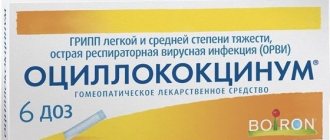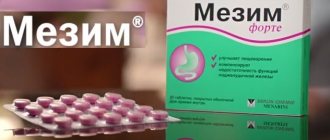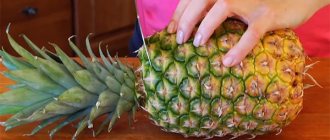During a seasonal outbreak of respiratory infections and pathogenic influenza, the population wants to protect itself, and when an illness begins, to cope with it as quickly as possible. The pharmacological industry and doctors offer a wide range of drugs for prevention and treatment: some are necessary to prevent the development of the disease, others treat - they act directly on the virus or eliminate the manifestations of pathology. For nursing mothers, there are restrictions on taking medications. Let's consider whether Oscillococcinum is indicated for use during breastfeeding.
Oscillococcinum is a homeopathic remedy with unproven effectiveness, but not harmful. Therefore, it is approved for use during breastfeeding.
Oscillococcinum: descriptive characteristics
Oscillococcinum is a homeopathic medicine produced by the French company Boiron. The therapeutic effect of the drug is determined by the action of its components:
- extract from the liver and heart of Barbary duck;
- sucrose;
- lactose.
The medicine is used during epidemics of infectious diseases of viral origin to activate the body's defenses. In addition, Oscillococcinum is effective against the first symptoms of colds.
The medication is produced in the form of white granules that quickly dissolve in water. Thanks to sucrose and lactose, homeopathic balls taste sweet, but their smell is neutral. The granules are packaged in small plastic tubes, each containing 1 serving (1g tablet) of the medicine. Each package contains 3 tubes, which is equal to 3 doses.
Thanks to the convenient dosage, patients do not have problems determining the dose.
Oscillococcinum is prescribed to prevent respiratory infections of viral origin and influenza during seasonal epidemics. In addition, the medicine is used for symptomatic treatment of the diseases described above, which are manifested by fever, headache, arthralgia, myalgia, etc.
The drug has been subjected to repeated medical studies. Experiments were carried out in Russia, America and other countries. According to test results, Oscillococcinum reduces the severity of cold and flu symptoms and speeds up recovery. Therefore, the drug is recommended to be taken as part of complex therapy for the diseases described above in patients of different age categories.
Description of the drug Oscillococcinum
This homeopathic remedy, invented by homeopath J. Roy, has been manufactured in a French laboratory for more than 60 years. For its production, an extract of the parenchymal organs of Muscovy ducks is used. The extract is subjected to ultra-high dilution of the active component, after which the drug practically does not contain it. Excipients are sucrose and lactose.
Oscillococcinum is produced in the form of white peas in a tube corresponding to one dose. The drug has a sweet taste, odorless, and easily dissolves in water.
Use of homeopathic medicine
The method of using the homeopathic medicine is sublingual, that is, it is dissolved under the tongue. This method is quite effective, since there are many blood vessels located under the tongue, which are located close to the surface. As a result, the drug immediately penetrates the bloodstream, bypassing the digestive system.
Take the granules 15 minutes before eating or 60 minutes after eating. If the patient violates this rule, the effectiveness of the drug will decrease or not appear at all.
As the instructions say, Oscillococcinum is taken at all stages of the flu or cold, and the dose of the medicine does not depend on the patient’s age:
- To prevent the disease, take 1 dose of the medicine, then dissolve 2 or 3 doses with an interval of 6 hours.
- At the first signs of influenza, the patient takes 1 dose of granules, then 2 or 3 at the same interval as in the previous case.
- To treat an acute disease, the patient takes 1 dose of the medicine with an interval of 12 hours for 1 to 3 days.
The duration of prophylaxis is 7 or 8 days, 1 serving. After completing the course, the body's defenses increase and the likelihood of contracting the flu or cold decreases. But if after taking the medication signs of the disease appear, then treatment is recommended.
If the child is unable to absorb the granules, then a single portion is dissolved in a small amount of cooled boiled water and given from a spoon or bottle.
Efficacy, price, contraindications for use, side effects
Today there is no clear opinion on the effectiveness of using Oscillococcinum for the treatment of colds. Many doctors, in principle, do not consider the use of homeopathic medicines to be an effective method of treatment. However, the results of medical studies of the effectiveness of the use of Oscillococcinum for the treatment of colds, conducted including in the USA and Russia, show that the drug somewhat helps to reduce the manifestation of symptoms of acute respiratory viral infections and acute respiratory infections, and is also able to speed up the healing process. A number of experts recommend the use of Oscillococcinum as part of complex therapy in the treatment of influenza and colds.
Reviews from ordinary consumers also indicate that Oscillococcinum can have a specific positive effect in the treatment of colds.
In case of acute ARVI or ARI, I always take it, and on the second or third day it’s already better. The placebo effect is excluded. The drug works, tested independently, without the advice of other people or advertising.
midnight90
https://otzovik.com/review_3931929.html
However, on the Internet you can find a sufficient number of reviews indicating the low effectiveness of this medicine.
Several years ago I first encountered this drug. The doctor strongly recommended it to me, but he just didn’t walk me to the pharmacy arm in arm. I bought it and drank it according to the regimen from the first day of ARVI. There was no point. I was treated the same way as always. Three years have passed. I started giving my daughter Oscillococcinum for a cold (again, according to a doctor’s prescription). The result is the same, nothing. Mom took this drug and also did not feel its effects. It’s good that at least it didn’t cause any side effects.
And then I became interested in what it is made of, this Oscillococcinum. And this is what I read: lactose, sucrose, and extract from the liver of a Barbary duck. So, sir, I think what kind of duck is this... I started looking. I couldn’t find it in the bird reference book. There is conflicting information on the Internet. Some write that this is a musky duck from distant Mexico, others - that this bird does not exist at all. Where then do they get her liver? Or have all Barbary ducks been switched to Oscillococcinum?
But this drug is actively advertised on TV and radio! Doctors prescribe it to their sick patients! And people believe! And they go to the pharmacy, leaving a lot of money there! Is this fair? In Turkey, there is only one punishment for counterfeiting medicines and producing similar drugs: the death penalty. Why is such a disgrace allowed in vast Russia? By the way, the other day I got into a conversation with a pharmacist at the pharmacy. She said that oscillococcinum sells out instantly after delivery, only then people come and ask for something else for acute respiratory viral infections and acute respiratory infections. This means that the Barbary duck does not help Russian people.
GrainOl
https://otzovik.com/review_497415.html
Modern doctors, who are supporters of evidence-based medicine, are more than skeptical about the effectiveness of homeopathic remedies in principle and Oscillococcinum in particular. For example, children’s doctor Evgeniy Komarovsky, who is popular today in the CIS countries, is convinced that Oscillococcin is a safe, but absolutely ineffective pacifier for the treatment of colds, acting on the placebo principle. Dr. Komarovsky openly says that even tea with honey can be more beneficial in the fight against influenza and ARVI.
Educational television programs also addressed the issue of the effectiveness of Oscillococcinum. We bring to your attention a fragment of the “Health” program with Elena Malysheva, where the advisability of using this drug for the treatment of influenza is also questioned.
Video: Flu medications that don't cure
The online encyclopedia Wikipedia also provides information according to which, based on the results of Russian and international clinical studies, the effectiveness of Oscillococcinum for the treatment of colds and flu has not been scientifically confirmed.
A meta-analysis of two preventive studies in Russia (327 patients) and four clinical trials in France and Germany (1196 patients) did not confirm the statistically significant preventive and therapeutic effectiveness of Oscillococcinum. The analysis summarizes that clinical trials and other scientific data on Oscillococcinum do not support the manufacturer's claimed preventive effect against influenza and influenza-like syndromes. There was no statistically significant difference between the effect of Oscillococcinum and placebo.
https://ru.wikipedia.org/wiki/Ocillococcinum
Thus, the question of responsibility for the choice of this drug in each specific case of disease falls on the shoulders of the patient.
Oscillococcinum is a fairly safe drug; in any case, situations of drug overdose have not been recorded; the manufacturer also reports that there is no information about the occurrence of side effects, but nevertheless warns about the possibility of allergic reactions (itching and skin rashes).
Contraindications include individual intolerance to individual components of the drug. In addition, Oscillococcinum is not recommended for use if the following conditions exist in a woman’s health:
- acquired or congenital lactase deficiency (can provoke digestive system disorders, for example, abdominal pain, bloating, loose stools, and so on);
- individual lactose intolerance;
- diabetes;
- glucose-galactose malabsorption.
The cost of the drug in Russian pharmacies varies from 300 to 400 rubles per package containing 6 doses. A package of 12 doses will cost 600–700 rubles.
Prices for medicines may vary depending on the number of doses and where the medicine is sold.
The time frame for combating the disease with Oscillococcinum can vary from several days to a week, depending on the severity of the disease, as well as the stage at which the drug was started. In addition, Oscillococcinum is rarely prescribed as a monotherapy, but is more often used in combination with other drugs, so it is not possible to unequivocally state that healing occurred within a certain time frame precisely as a result of the use of this particular drug.
Instructions for use
It is recommended to use the drug either when early signs of the disease appear, or to prevent its onset in conditions of the rapid spread of epidemics of cold-viral diseases. The medication can also be used to treat a variety of symptoms of colds, for example, fever, headache and other manifestations.
The use of the drug consists in the complete resorption of the tablets under the tongue, where a large number of blood vessels are located, which allows the product to quickly enter directly into the blood, and not into the digestive system. This method of taking medication is called sublingual. It is recommended to take the medicine either 15 minutes before meals or 60 minutes after meals. The manufacturer claims that if the dosage regimen is not followed, the drug effect can be significantly reduced.
Oscillococcinum should be dissolved by placing a tablet under the tongue
The manufacturer recommends taking the medicine at any stage of the development of a cold; only the recommended dosages differ (the deeper the phase of the disease, the more intense the therapy should be). There is no correlation between the dosage of the drug and the age of the patient.
Thus, to prevent illness, it is recommended to take 1 serving of medicine per week during epidemics of colds. If early signs of a cold appear, it is necessary to take 1 portion of the medicine as soon as possible, and then, if the need continues, another 2 or 3 portions with an interval of 6 hours. In case of an intense course of the disease, it is recommended to take 1 portion of the medicine every 12 hours (after getting up in the morning and before bed) for 1–3 days. If symptom relief does not occur within 24 hours, you should consult a medical specialist.
These are the manufacturer’s standard recommendations, but to obtain more effective results, it is recommended to listen to the advice of your attending physician, who will prescribe complex therapy and set dosages individually, in accordance with your health condition and the course of the disease.
Precautionary measures
As indicated in the instructions, Oscillococcinum is prohibited from taking in the following cases:
- Allergy to the components of the drugs.
- Impaired absorption of glucose and galactose in the small intestine.
- Sucrose-isomaltose deficiency.
- Fructose malabsorption.
When breastfeeding and pregnancy, the drug is taken after the doctor's permission. If there are contraindications, the likelihood of allergic reactions in the form of skin rash, redness and itching increases. Adverse reactions occur extremely rarely. There is no information on drug overdose.
The drug is most effective when treated in the early stages of the disease. If cold symptoms become more pronounced within 24 hours after taking the granules, you should consult a doctor.
Oscillococcinum does not affect the patient's memory concentration and psychomotor reactions. That is why the medication is allowed to be taken before activities that require increased alertness and reaction speed.
Before purchasing a medicine, you should pay attention to its production date. The homeopathic medicine is valid for 5 years. Store the medication in a dark place, and the temperature should not exceed +25°C.
Oscillococcinum can be purchased at a pharmacy without a doctor's prescription. However, consult your doctor before using the medicine.
Use during pregnancy and lactation: possible or not
For nursing mothers, Oscillococcinum is prescribed as the main treatment in the initial stages of a cold. Included in the Top 5 remedies recommended for ARVI for pregnant women and children. It is unknown whether the medicine passes into breast milk, but due to its tiny proportion in the composition, it is definitely safe for the baby.
An analysis of reviews did not record a single fact of side effects of the drug, including during lactation. Therefore, to the question: “Can Oscillococcinum be given to nursing mothers?” therapists answer “yes.” However, the effectiveness of the drug is highly questionable. And, given the controversial reputation of homeopathic medicine, in complicated cases, doctors prefer traditional medicines.
Oscillococcinum with hepatitis B
As the abstract states, Oscillococcinum is taken during lactation and pregnancy as prescribed by a doctor. Many nursing mothers note the positive effects of the drug, only some claim that the medication was not effective. This is often explained by the fact that the woman began treatment during an exacerbation of the disease, and during therapy she used only a homeopathic remedy. Although at the acute stage of the disease Oscillococcinum is combined with other anti-influenza drugs.
The drug normalizes the immune system, which produces more cells and eliminates the symptoms of the disease. Colds are caused by oscillococci; a large number of these microorganisms are found in the liver of the Barbary duck. As already mentioned, Oscillococcinum is made from an extract from this organ. Thanks to this component, the immune system is activated and the body resists the disease. Based on this, a homeopathic remedy does not relieve symptoms, but eliminates the cause of the disease in a natural way.
Thus, Oscillococcinum is allowed to be taken while breastfeeding. However, before using the drug, you should consult a doctor, who will determine the appropriate dosage and determine the treatment plan.
Subscribe to our VKontakte group
Composition and principle of action
The product is based on an extract of the liver and heart of a musk duck. Auxiliary components are sucrose (0.85 g) and glucose (0.15 g). The capsules are sweet and white.
As with all homeopathic medicines, the active ingredients are contained in Oscillococcinum in extremely low quantities, in multiple dilutions.
The drug is popular in the world, especially in the homeland of the manufacturer (BOIRON) in France: 80% of the country's population takes Oscillococcinum for colds.
Indications:
- initial stages of influenza;
- ARVI.
The effectiveness of the drug is declared at the first signs of the disease and as a prophylactic agent. It is recommended to use second-line therapy in combination with the main drug.
Contraindications:
- individual lactose intolerance;
- lack of lactase;
- glucose malabsorption.
In patients without a negative reaction to disaccharides, no side effects were observed. The drug is used for children from infancy.
Side effects on the body and overdose
Adverse reactions from Oscillococcinum rarely develop in women during the lactating period. In the vast majority of patients, they are associated with individual intolerance to the components of the drug and manifest themselves in the form of redness on the skin, rash and itching. The same symptoms may occur in a baby receiving breast milk from a mother who is taking Oscillococcinum. If undesirable reactions to the drug occur, the woman should stop using it further and seek medical help. If the described side symptoms are observed in an infant, he should be weaned for 48 hours and immediately shown to a pediatrician.
Use of Oscillococcinum during breastfeeding
According to homeopaths, Oscillococcinum is better suited than other medicines for use during breastfeeding. It contains no dangerous components, so it can be used during lactation, unlike drugs such as ACC, Bromhexine, Ambroxol and the like. At the same time, this remedy, like any other drug, may simply not be suitable - in this case, there will be no result from its use.
READ ALSO: Citramon: instructions for use during lactation
A nursing mother can use this drug both for the treatment of diseases and for their prevention during influenza epidemics or other acute viral respiratory tract infections. In the first case, the mother should start taking the drug as early as possible - according to reviews, the effect of it is almost absent if treatment is not started in the first days of the disease.
The use of oscillococcinum during breastfeeding
Treatment of flu or colds during breastfeeding may require certain rules. Several points can be described:
- Oscillococcinum during lactation has the usual contraindications and indications for use.
- There is no effect of the drug on a nursing mother, so the standard dosage is used.
- The dosage may be increased if necessary. You will have to use the drug after consulting a doctor.
- It is also worth mentioning problems with milk, establishing guards. There is no need to skip feedings or express milk.
- Take Oscillococcinum after meals with plenty of water. After taking it, it is recommended to monitor the baby’s condition.
The effects of the medicine have been sufficiently studied, so if a mother has a question about whether Oscillococcinum can be used during breastfeeding, the answer will be positive.
Oscillococcinum during breastfeeding, can nursing mothers take it?
After childbirth, a woman’s body weakens and all its strength is mobilized for breastfeeding. It becomes more difficult for a nursing woman's immune system to cope with bacteria and viruses, so young mothers often face unpleasant diseases like the flu or ARVI. Many therapists recommend that a nursing woman take Oscillococcinum, which we will consider.
Why is Oscillococcinum prescribed during lactation?
Oscillococcinum is a homeopathic remedy approved for use by pregnant and lactating women. There have been heated discussions on the effectiveness of homeopathic remedies in recent decades. But so far there is no evidence base on the effectiveness of the drug. Doctors have concluded that it does not exceed the placebo effect (self-hypnosis).
Since 2021, homeopathy has been officially recognized as pseudoscience, its effect is attributed to the placebo effect
On February 6, 2021, homeopathy was officially recognized as a pseudoscience.
The RAS Commission (Russian Academy of Sciences) issued a memorandum reporting the ineffectiveness of homeopathic medicines.
The memorandum is advisory and educational in nature, it does not prohibit the sale and use of such medicines, therefore they are still sold in pharmacies.
According to the manufacturer, Oscillococcinum is able to fight viral infections and influenza. It is assumed that to treat a disease caused by a certain substance, it is necessary to use the same drug in ultra-low doses. To do this, it is diluted with water tens of thousands of times.
The concentration of the active ingredient is ultimately so low that evidence-based medicine could not detect it in the drug. However, despite the seeming absurdity of the product and the opinions of many ironically minded skeptics, you can read a huge number of positive reviews about the drug.
Despite the proven ineffectiveness of the drug, millions of mothers from more than 30 countries have been treating themselves and their children with Oscillococcinum for decades (Oscillococcinum has been produced for about 70 years).
Despite the recognition by medicine of the ineffectiveness of Oscillococcinum, there are many positive reviews about the use of this remedy
Active and auxiliary components of the composition
To produce Oscillococcinum, an extract from the liver and heart of the musky duck is used. The concentration of the active component in Oscillococcinum is 10–400.
These numbers mean the complete absence of entire molecules of the substance in the entire package of the drug, that is, in fact, it is not there.
Representatives of homeopathy claim that the effect of the product, despite the minuscule concentration of the active substance, is due to the “water memory” effect.
When it comes into contact with any component, it modifies (changes without violating the basic properties) its structure (this theory has not received a single experimental confirmation). Moreover, Oscillococcinum does not contain water. Of the detectable components in the preparation, only sucrose and lactose are present, acting as auxiliary ones.
Food for thought: in terms of its composition and active substance, Oscillococcinum has no analogue in the world.
Here's what a company representative answered when asked about the safety of using a drug based on poultry liver:
Of course it's safe. There's nothing in it.
Gina Casey
https://ru.wikipedia.org/wiki/Ocillococcinum
Indications and contraindications
Oscillococcinum is used on the recommendation of a doctor to treat the following health problems:
- acute respiratory viral infections (ARVI);
- mild to moderate flu.
The drug can also be taken to prevent colds and flu by adults and children of any age, including newborns. Oscillococcinum is well tolerated and does not cause side effects. However, the manufacturer warns about the theoretical possibility of allergic reactions.
There have been no overdose episodes recorded in the entire history of the drug's release. It is possible to take Oscillococcinum with other therapeutic drugs.
Oscillococcinum is contraindicated in the following cases:
- with individual sensitivity to components;
- with lactose intolerance;
- with glucose-galactose malabsorption.
Method and scheme for using granules
Like many other homeopathic remedies, Oscillococcinum comes in the form of white round granules. They are packaged in small plastic containers of 1 gram - homeopaths call them doses. These containers are packed in a blister. The drug is sold in pharmacies in 2, 4 and 10 blisters with 3 doses.
It is recommended to start treatment with the drug as quickly as possible when the first signs of the disease appear. The sooner this is done, the easier the disease will progress and the faster recovery will occur. The scheme is as follows:
- The initial dose should be taken immediately after the first symptoms appear.
- Then, if necessary, you can repeat the dose 2 or 3 times with an interval of 6 hours.
- Further, if the disease has already developed, Oscillococcinum is taken 1 hour after meals or 15 minutes before meals twice a day.
To prevent colds, the manufacturer recommends taking 1 dose of the drug every week during the ARVI season.
The patient's weight and age do not affect the dosage of the drug. The granules must be kept under the tongue until they are completely dissolved.
For infants, Oscillococcinum can be mixed in a spoonful of water and offered mixed with milk or formula.










